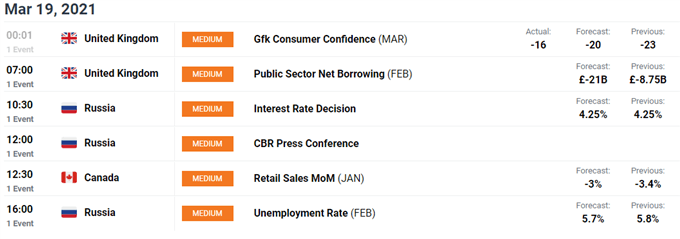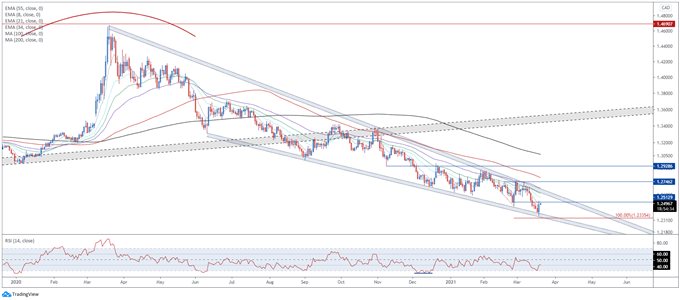Canadian Dollar, Bank of Canada, USD/CAD, Crude Oil, Quantitative Easing – Talking Points:
- Equity markets tumbled lower during APAC trade as global bond markets continued to sell-off.
- Better-than-expected retail sales data may underpin the Canadian Dollar against its US counterpart.
- Bullish Engulfing candle hints a rebound higher is on the cards for USD/CAD.
Asia-Pacific Recap
Equity markets tumbled during the Asia-Pacific session as global bond markets continued to sell-off. Japan’s Nikkei 225 plunged 1.13% as the Bank of Japan stated that it would focus on buying ETFs from the TOPIX instead of the Nikkei. Policymakers also widened the band around the BoJ’s 10-year bond yield target from 0.2% to 0.25%.
Australia’s ASX 200 fell 0.43% on the back of disappointing retail sales data, while tense in-person talks between US and Chinese diplomats triggered a 1.2% sell-off in China’s CSI 300. In FX markets, AUD, GBP and CAD slipped marginally lower while the haven-associated USD and JPY held relatively steady. Crude oil prices rebound over 1% higher after toppling 7.6% overnight.
Looking ahead, consumer confidence figures out of the UK headline the economic docket alongside retail sales figures out of Canada.

Crude Oil Correction, Surging Yields Underpinning USD/CAD
The USD/CAD exchange rate rebounded robustly overnight, climbing 0.66% higher on the back of a sharp correction in crude oil prices and a surge in US Treasury yields. US 10-year Treasury yields surged above 1.70% for the first time since January of last year, while a fresh wave of coronavirus-enforced lockdowns in France stoked fears that global mobility may not rebound as quickly as expected, ultimately triggering a 7% collapse in crude oil prices.
However, these dynamics may only temporarily weigh on the Canadian Dollar in the short-term, given the expectation from market participants that the Bank of Canada may taper its Quantitative Easing measures at its monetary policy meeting in April, in response to extremely strong jobs data.
The nation’s unemployment rate fell 1.2% to 8.2% in February drastically exceeding consensus estimates, while the participation rate held firm at 64.7%. This overwhelming drop in joblessness comes in spite of the majority of the country still operating under the tightest restrictions seen since the inception of the pandemic, according to the Oxford Covid-19 Government Response Tracker.
The vaccine rollout has also been relatively cumbersome, with only 7.4% of the population receiving at least one dose of a coronavirus vaccine. This is significantly lower than the levels seen in the United States (22%) and United Kingdom (37.2%).

Therefore, it seems reasonable to expect the local economic recovery to pick up rapidly as the vaccination rate increases. Moreover, with BoC Deputy Governor Lawrence Schembri stating that the central bank “now expect that inflation will move temporarily above our 2% target in the coming months, to around the top of the 1 to 3% control range”, tapering QE measures could be a distinct possibility.
Especially when considering that the central bank has already reduced its total bond purchases from $5 billion to $4 billion a week, and Governor Tiff Macklem’s prior warnings that “as much as bold policy response is needed, it will inevitably make the economy and financial system more vulnerable to economic shocks down the road”.
With that in mind, better-than-expected retail sales figures for January could provide further fuel to the tapering fire and open the door for the Loonie to climb higher against its US Dollar counterpart.
USD/CAD Daily Chart – Bullish Engulfing Candle Could Ignite Short-Term Recovery

USD/CAD daily chart created using Tradingview
From a technical perspective, the longer-term outlook for USD/CAD rates remains skewed to the downside, as prices track firmly below the 55-, 100- and 200-period moving averages.
However, a Bullish Engulfing candle close, in tandem with the RSI failing to die into oversold territory, hints that a near-term reversal could be on the cards.
A daily close back above the 8-EMA (1.2500) could pave the way for the exchange rate to rebound back towards former support-turned-resistance at the March 4 low (1.2575).
However, if that holds firm, a continuation of the downtrend extending from the March 2020 high seems reasonably likely.
A convincing break below the yearly low (1.2365) is ultimately required to bring the 2018 low (1.2247) into the crosshairs.

The IG Client Sentiment Report shows 71.56% of traders are net-long with the ratio of traders long to short at 2.52 to 1. The number of traders net-long is 14.91% lower than yesterday and 6.66% higher from last week, while the number of traders net-short is 0.30% higher than yesterday and 14.91% lower from last week.
We typically take a contrarian view to crowd sentiment, and the fact traders are net-long suggests USD/CAD prices may continue to fall.
Positioning is less net-long than yesterday but more net-long from last week. The combination of current sentiment and recent changes gives us a further mixed USD/CAD trading bias.
-- Written by Daniel Moss, Analyst for DailyFX
Follow me on Twitter @DanielGMoss

